On a test drive of the Buick Regal CXL last fall, your writer came away impressed by numerous things – including measured fuel economy.
In its time with me, Regal’s standard 2.4L direct-injected 4-cylinder engine and six-speed automatic transmission sucked back a test average of 9.2L/100km, with high-speed cruising mileage landing around 7L/100km.
In a car that’s ready for four adults, that’s pretty darn good indeed.
For 2012, engineers have furthered Regal’s potential fuel economy – adding a so-called ‘light electrification’ system called eAssist to the options roster. Enhancing the standard powertrain with an electric drive system and battery pack to lighten the load on its gas engine, it promises compromise-free fuel economy improvements.
And since eAssist is cheaper and less complex than a full-out hybrid system, the added benefits come on the cheap. And it’s not all “in your face” about its greenness, either.
eAssist allows the Regal’s front wheels to both create and receive electrical power by way of a special ‘motor generator’ unit that replaces the traditional alternator. That motor generator is connected to the engine, which is connected to the transmission, and thus, the wheels.
The motor generator is tapped into the driving force of the front wheels. When drivers coast or brake, power isn’t required, and the motor generator switches to ‘generator’ mode. While there, it spins via the force of the wheels, and it generates electricity for storage in a trunk-mounted battery.
This process is called ‘regenerative braking,’ and it effectively uses unneeded momentum to recharge the battery rather than a standard, fuel-sucking alternator.
Conversely, when drivers accelerate hard, stored electricity is fed into the motor generator via its ‘motor’ mode – where it can add up to 15 horsepower worth of electric ‘boost’ to the gas engine. When climbing a hill or merging, the stored electricity can be used to give the Regal a little ‘push’, in place of additional throttle or downshifting.
Start-stop functionality is also enabled, meaning the Regal eAssist won’t needlessly spew filth into the atmosphere while stopped at a light.
Following a recent 2,500-km test drive of a Regal eAssist, a few observations proved worth sharing.
First, the whole system is extremely discreet. There’s virtually no vibration or noise as the gas engine starts and stops – which it does in a blink. The process is smoother than similar systems I’ve experienced in models from Porsche, Mercedes and BMW.
The Regal eAssist is also remarkably free of the slight squirms felt through the driveline in some other models that blend gas and electric power for propulsion.
Regal eAssist literally drives just like a normal car – largely because it is one. It’s not a hybrid. It can’t drive solely on stored electricity. It’s only got a small battery pack and it’s fun to drive and normal looking, where many hybrids aren’t.
And other than a missing chunk of trunk space chewed up by the battery pack, this Regal functions and looks just like the standard car, too. It doesn’t even wear a special badge.
It requires nothing more of the driver. You hop in, start it, shift it and drive it exactly the same as you would the standard machine. If not for some subtle changes to the instrument cluster, including an ‘ECO’ meter and ‘AUTO STOP’ position on the tachometer, you’d be hard pressed to tell the difference.
All said, engineers say drivers should achieve about 20 percent reduction in fuel use.
Mileage during my watch? Measured by hand, I achieved 8.3L/100km combined. That’s about 10 percent less than the standard car, driven in similar conditions across Northern Ontario. Note that my assigned tester wore snow tires, which use up a bit of fuel, too.
Ultimately, actual mileage is largely a function of your driving habits, locale and more. But this green technology does work, and it’s not all in your face about it either.
Units are available for test drive now.
In its time with me, Regal’s standard 2.4L direct-injected 4-cylinder engine and six-speed automatic transmission sucked back a test average of 9.2L/100km, with high-speed cruising mileage landing around 7L/100km.
In a car that’s ready for four adults, that’s pretty darn good indeed.
For 2012, engineers have furthered Regal’s potential fuel economy – adding a so-called ‘light electrification’ system called eAssist to the options roster. Enhancing the standard powertrain with an electric drive system and battery pack to lighten the load on its gas engine, it promises compromise-free fuel economy improvements.
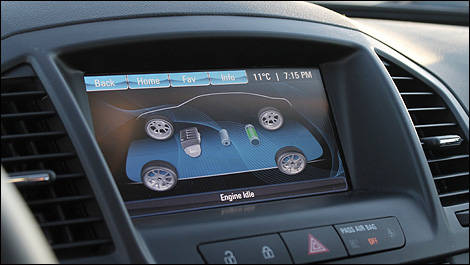 |
| Photo: Justin Pritchard/Auto123.com |
And since eAssist is cheaper and less complex than a full-out hybrid system, the added benefits come on the cheap. And it’s not all “in your face” about its greenness, either.
eAssist allows the Regal’s front wheels to both create and receive electrical power by way of a special ‘motor generator’ unit that replaces the traditional alternator. That motor generator is connected to the engine, which is connected to the transmission, and thus, the wheels.
The motor generator is tapped into the driving force of the front wheels. When drivers coast or brake, power isn’t required, and the motor generator switches to ‘generator’ mode. While there, it spins via the force of the wheels, and it generates electricity for storage in a trunk-mounted battery.
This process is called ‘regenerative braking,’ and it effectively uses unneeded momentum to recharge the battery rather than a standard, fuel-sucking alternator.
Conversely, when drivers accelerate hard, stored electricity is fed into the motor generator via its ‘motor’ mode – where it can add up to 15 horsepower worth of electric ‘boost’ to the gas engine. When climbing a hill or merging, the stored electricity can be used to give the Regal a little ‘push’, in place of additional throttle or downshifting.
Start-stop functionality is also enabled, meaning the Regal eAssist won’t needlessly spew filth into the atmosphere while stopped at a light.
Following a recent 2,500-km test drive of a Regal eAssist, a few observations proved worth sharing.
First, the whole system is extremely discreet. There’s virtually no vibration or noise as the gas engine starts and stops – which it does in a blink. The process is smoother than similar systems I’ve experienced in models from Porsche, Mercedes and BMW.
The Regal eAssist is also remarkably free of the slight squirms felt through the driveline in some other models that blend gas and electric power for propulsion.
Regal eAssist literally drives just like a normal car – largely because it is one. It’s not a hybrid. It can’t drive solely on stored electricity. It’s only got a small battery pack and it’s fun to drive and normal looking, where many hybrids aren’t.
And other than a missing chunk of trunk space chewed up by the battery pack, this Regal functions and looks just like the standard car, too. It doesn’t even wear a special badge.
It requires nothing more of the driver. You hop in, start it, shift it and drive it exactly the same as you would the standard machine. If not for some subtle changes to the instrument cluster, including an ‘ECO’ meter and ‘AUTO STOP’ position on the tachometer, you’d be hard pressed to tell the difference.
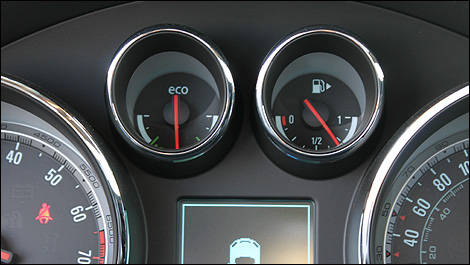 |
| Photo: Justin Pritchard/Auto123.com |
All said, engineers say drivers should achieve about 20 percent reduction in fuel use.
Mileage during my watch? Measured by hand, I achieved 8.3L/100km combined. That’s about 10 percent less than the standard car, driven in similar conditions across Northern Ontario. Note that my assigned tester wore snow tires, which use up a bit of fuel, too.
Ultimately, actual mileage is largely a function of your driving habits, locale and more. But this green technology does work, and it’s not all in your face about it either.
Units are available for test drive now.
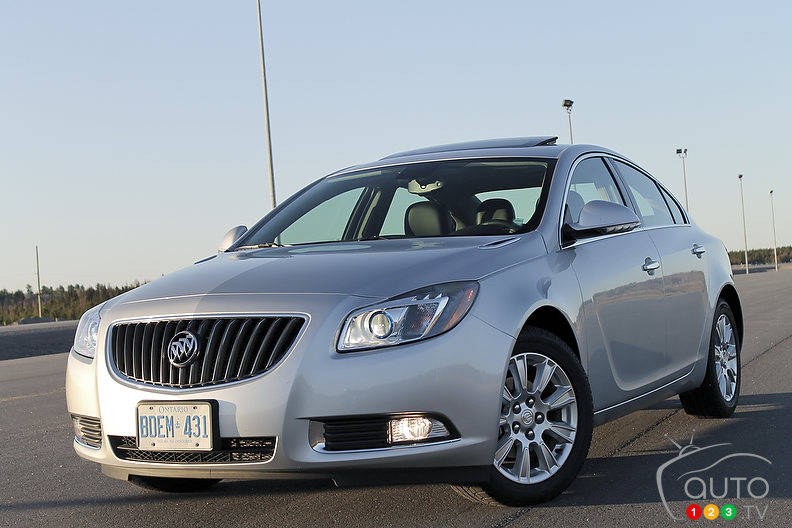
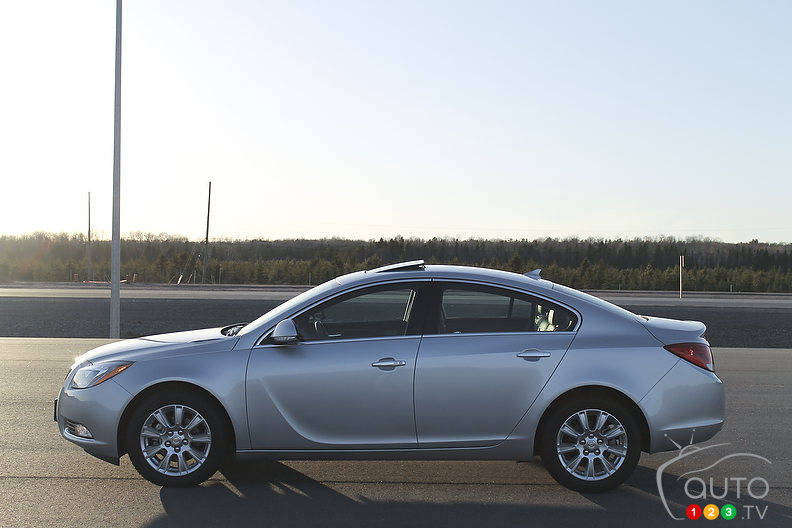
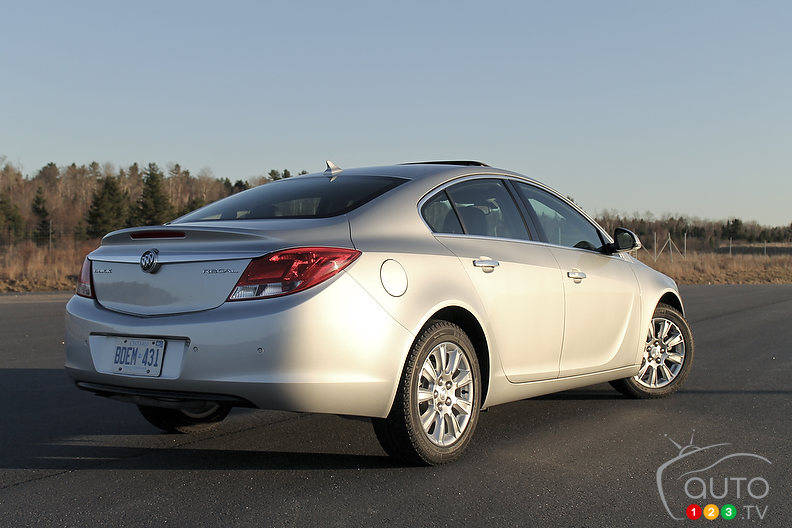
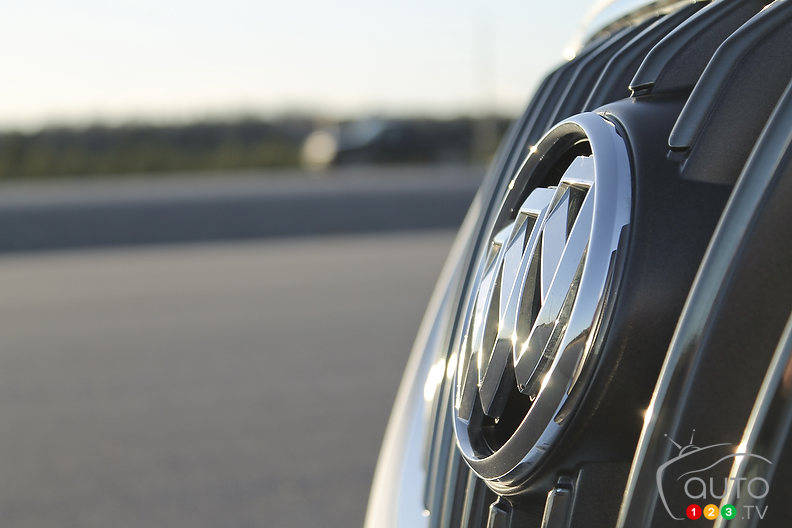
Article Gallery


